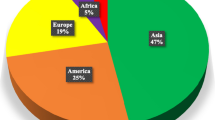
Overview
- First published book on Google Earth Engine, a platform with exponentially growing use
- Collects techniques and perspectives of prominent users of Earth Engine
- Organized to allow users with multiple experience levels to easily find an entry point
- This book is open access, which means that readers have free and unlimited ability to use the materials
Buy print copy
Tax calculation will be finalised at checkout
About this book
Cloud Based Remote Sensing with Google Earth Engine is broadly organized into two halves. The first half, Fundamentals, is a set of 31 labs designed to take the reader from being a complete Earth Engine novice to being a quite advanced user. The second half, Applications, presents a tour of the world of Earth Engine across 24 chapters, showing how it is used in a very wide variety of settings that rely on remote-sensing data
This is an open access book.
Similar content being viewed by others
Keywords
Table of contents (55 chapters)
-
Front Matter
-
Programming and Remote Sensing Basics
-
Front Matter
-
-
Advanced Image Processing
-
Front Matter
-
-
Interpreting Image Series
-
Front Matter
-
Editors and Affiliations
About the editors
An Associate Professor at McGill University, Jeff is trained in landscape ecology, computer science, and remote sensing / GIS. A very early adopter of Earth Engine, his research focuses on ingesting multiple data sources to improve land-cover classifications, by smoothing inconsistencies through time and accumulating evidence of land cover change and stability. Through the years, one of the challenges in training new graduates and undergraduates has been finding training materials that both teach fundamentals and present interesting applications of using satellites for cutting-edge environmental science. Jeff hopes that this effort will appeal to individuals working on their own to understand this powerful technology. He has a Bachelor’s Degree in Applied Mathematics and Computer Science from Carnegie-Mellon University, a Master of Science in Operations Research from the Georgia Institute of Technology, and a PhD in Environmental Monitoring from the University of Wisconsin-Madison.
Nick Clinton
Nick is on the Earth Engine developer relations team. He received a bachelors, masters and PhD from the Department of Environmental Science, Policy and Management at UC Berkeley. From 2008-2011, Nick worked in the Airborne Sensor Facility of NASA Ames Research Center, producing science quality calibrated imagery and supporting sensor maintenance for thermal, multispectral and hyperspectral imagers. From 2012-2015, he was on the faculty of the Center for Earth System Science at Tsinghua University, in Beijing, China. He joined Google in 2015.
Morgan A. Crowley
Morgan is a Forest Fire Research Scientist with NRCan at the Great Lakes Forestry Centre - Canadian Forest Service and the Tier 2 scientific lead of the WildFireSat mission that will be launched in 2028. She recently completed her Ph.D. at McGill University, where her research explored novel applications of fire monitoring using Google Earth Engine and multi-sensor satellite data fusion. Morgan has been recognized for her research and outreach using Google Earth Engine, including as a 2022-2023 Google Developer Expert, a Geospatial Rising Star by Geospatial World Media, and a leader in ML4EO by Radiant Earth Foundation. She is also the co-director of the Ladies of Landsat organization, which works to increase support for underrepresented scientists in the field of remote sensing.
David Saah
A Professor at the University of San Francisco, David is an environmental scientist with expertise in a number of areas including: landscape ecology, ecosystem ecology, hydrology, geomorphology, ecosystem modeling, natural hazard modeling, remote sensing, geographic information systems (GIS) and geospatial analysis. His academic research uses integrated geospatial science for multi–scale mapping, monitoring and modeling of environmental spatial heterogeneity, particularly in riparian, savanna, and forest ecosystems. Dr. Saah’slong-running work with the NASA SERVIR project has focused on outreach to developing nations, working to build knowledge infrastructure to solve pressing environmental problems.
Bibliographic Information
Book Title: Cloud-Based Remote Sensing with Google Earth Engine
Book Subtitle: Fundamentals and Applications
Editors: Jeffrey A. Cardille, Morgan A. Crowley, David Saah, Nicholas E. Clinton
DOI: https://doi.org/10.1007/978-3-031-26588-4
Publisher: Springer Cham
eBook Packages: Chemistry and Materials Science, Chemistry and Material Science (R0)
Copyright Information: The Editor(s) (if applicable) and The Author(s) 2024
Hardcover ISBN: 978-3-031-26587-7Published: 05 October 2023
Softcover ISBN: 978-3-031-26590-7Published: 05 October 2023
eBook ISBN: 978-3-031-26588-4Published: 04 October 2023
Edition Number: 1
Number of Pages: XXI, 1226
Number of Illustrations: 29 b/w illustrations, 1464 illustrations in colour
Topics: Monitoring/Environmental Analysis, Analytical Chemistry, Computer Imaging, Vision, Pattern Recognition and Graphics, Signal, Image and Speech Processing, Data Structures and Information Theory, Artificial Intelligence



